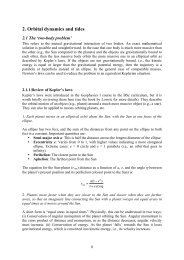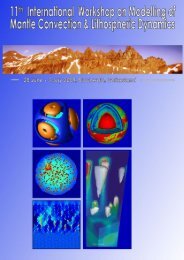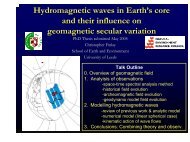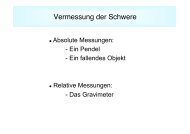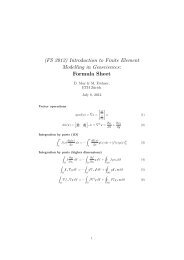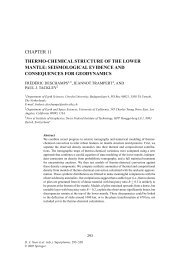Hydromagnetic waves in Earth's core and their influence on ...
Hydromagnetic waves in Earth's core and their influence on ...
Hydromagnetic waves in Earth's core and their influence on ...
Create successful ePaper yourself
Turn your PDF publications into a flip-book with our unique Google optimized e-Paper software.
79 Chapter 3 — Historical fieldmeasurement methods that would produce such a spatially <str<strong>on</strong>g>and</str<strong>on</strong>g> temporally coherentsignal <strong>on</strong> these l<strong>on</strong>g time scales, imply<str<strong>on</strong>g>in</str<strong>on</strong>g>g that this must be a genu<str<strong>on</strong>g>in</str<strong>on</strong>g>e mode of magneticfield evoluti<strong>on</strong> at the <str<strong>on</strong>g>core</str<strong>on</strong>g> surface.Other signals identified <str<strong>on</strong>g>in</str<strong>on</strong>g> ˜B r <str<strong>on</strong>g>in</str<strong>on</strong>g>clude a weaker m=7 signal found at low to mid latitudes<str<strong>on</strong>g>in</str<strong>on</strong>g> the northern hemisphere <str<strong>on</strong>g>and</str<strong>on</strong>g> a m=2, 3 signal that is str<strong>on</strong>gest at mid latitudes <str<strong>on</strong>g>in</str<strong>on</strong>g> thesouthern hemisphere. The m=7 signal is observed most clearly near to latitude 30 ◦ N<str<strong>on</strong>g>in</str<strong>on</strong>g> the 20th century though it is <str<strong>on</strong>g>in</str<strong>on</strong>g>itially located at lower latitudes <str<strong>on</strong>g>and</str<strong>on</strong>g> slowly driftsnorthward. It has frequency f=0.004 cpyr (a period of around 250 years) <str<strong>on</strong>g>and</str<strong>on</strong>g> moveswestward at an average speed of around 12 km yr −1 . The m=2, 3 signal is observedmost clearly between 20 ◦ S <str<strong>on</strong>g>and</str<strong>on</strong>g> 40 ◦ S <str<strong>on</strong>g>and</str<strong>on</strong>g> has a frequency of 0.0042 cpyr (a period of 235years) <str<strong>on</strong>g>and</str<strong>on</strong>g> moves rapidly westward at an average speed of 30 km yr −1 . It is str<strong>on</strong>gesttowards the end of the historical record (especially after 1800), <str<strong>on</strong>g>and</str<strong>on</strong>g> at l<strong>on</strong>gitudes 150 ◦ E to90 ◦ W. It was further found that although the highest amplitude, spatially <str<strong>on</strong>g>and</str<strong>on</strong>g> temporallycoherent patterns of field evoluti<strong>on</strong> were located <str<strong>on</strong>g>in</str<strong>on</strong>g> the Atlantic hemisphere, weakerpatterns with similar form were also present <str<strong>on</strong>g>in</str<strong>on</strong>g> the Pacific hemisphere.It was not possible to detect either dispersive behaviour or any systematic geographictrends <str<strong>on</strong>g>in</str<strong>on</strong>g> azimuthal speeds of field features. These are properties associated with hydromagneticwave propagati<strong>on</strong> mechanisms <str<strong>on</strong>g>in</str<strong>on</strong>g> rapidly rotat<str<strong>on</strong>g>in</str<strong>on</strong>g>g fluids (see chapter 6). Thenegative results obta<str<strong>on</strong>g>in</str<strong>on</strong>g>ed therefore suggest that the azimuthal moti<strong>on</strong> of the wave-likepatterns <str<strong>on</strong>g>in</str<strong>on</strong>g> B r may be more c<strong>on</strong>sistent with advecti<strong>on</strong> by azimuthal flow than withhydromagnetic wave propagati<strong>on</strong> <str<strong>on</strong>g>in</str<strong>on</strong>g> the <str<strong>on</strong>g>core</str<strong>on</strong>g>. Wave propagati<strong>on</strong> as a mechanism forazimuthal magnetic field moti<strong>on</strong> cannot be ruled out <strong>on</strong> the basis of the results of thischapter, but there is no str<strong>on</strong>g evidence <str<strong>on</strong>g>in</str<strong>on</strong>g> its favour.




